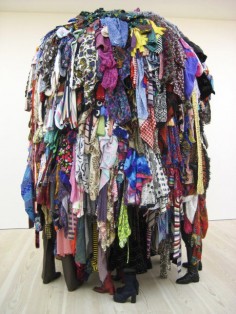GUERRA DE LA PAZ
NINE
source: mbandf
The theme of unity crops up again in Nine, a massive mound of clothing with strata of prom dresses, Christmas jumpers and embarrassing yesteryear fads, bearing down with the weight of a civilisation and its “disowned memories”. Beneath the fringes of the hulking mass can be seen the feet of nine people supporting the load – a testimony to the strength and value of community.
.
.
.
.
.
.
.
source: fubiznet
Le duo d’artistes Guerra de la Paz, composé d’Alain Guerra et de Neraldo de la Paz, ont réussi avec intelligence ce pari de recycler de vieux vêtements pour créer des oeuvres d’art. Une réelle fraîcheur et un talent indéniable se dégagent de ces compositions.
.
.
.
.
.
.
.
source: saatchigallery
Cuban born American artists Alain Guerra and Neraldo de la Paz are the collabortive duo Guerra de la Paz . Originally sourcing their materials from the waste bins of second-hand goods shipping companies in Miami’s Little Haiti, Guerra De La Paz make their sculptures from the discarded items of daily life. Viewing their practice as a kind of ‘archaeology’, their work engages with the history inherent in common debris and its possibility for recycled usage. In Nine, a giant mound of clothing heaps with strata of prom dresses, Christmas jumpers, and embarrassing yesteryear fads, bearing down with the weight of a civilisation and its disowned memories. Beneath the fringes of the hulking mass can be seen the feet of nine people supporting the load, a testimony to the strength and value of community.
.
.
.
.
.
.
.
source: odditycentral
Guerra de la Paz is the name of an artistic duet, made up of Alain Guerra and Neraldo de la Paz, two Cuban artists who live and work in Miami, Florida.
Since the favorite art medium of Guerra and de la Paz is clothing, the two find procure their material from waste bins and second hand shipping companies in Miami’s Little Haiti. Guerra de la Paz views its efforts of looking for discarded clothing as a form of archaeology. Each item is a relic that defines an individual’s personality, and together with other recycled clothes allows the artist to reinvent classic icons and historic themes, and send a message about the need for recycling, at the same time.
The works of Guerra de la Paz have been exhibited in galleries across America and Europe and have received positive reviews, ever since the project was born, in 1996.
.
.
.
.
.
.
.
source: vernissagetv
Guerra de la Paz have been, in their neighborhood, the silent spectators to the abandoned garments that anonymous owners have left laying around over the past years, discarded clothing swaying in the air as it struggles to be freed from barbed wire, expecting to fly towards the sovereignty that always caresses but never leads. These accounts give birth to Barbed, an exhibition that through installation and photography becomes a testimony of the controlled attempts to generate a submissive and oppressed population by psychologically manipulating the perceptions and behaviors of the masses through deceptive and abusive tactics.
Inspired by these images of desire overpowered by domination and by references to the diabolical historical events in death camps, Unidentified arises as an isolated sculptural installation that encapsulates the notions of oppression with its mounds of clothing bulging out while confined within a chain-linked fence crowned by barbed wire; a prison that consumes the essence by grabbing on to whatever residue of it lies within the discarded garments. A representation of an ancient and yet current dilemma, Unidentified will be the central piece of the exhibition, attracting the viewer’s attention to the struggle for freedom that in one way or the other characterizes contemporary society, while also exploring and reinventing the classic icons that have throughout history represented domination.
Through a common aesthetic, Guerra de la Paz creations work with a universal message, this one not being an exception. Understanding that the world is going through a time of global and political change, economical and social turmoil, Barbed serves the double purpose of being an acknowledgment of the victims of tyranny as well as a reminder of the fact that history often repeats itself. As Guerra de la Paz comment about the installation: “referencing carnage and genocide, the dirty laundry of society is embodied in the garments and allegorically personifies the innocent multitudes sacrificed for the sake of a few”.
Guerra de la Paz is the composite name that represents the creative duo efforts of Cuban born artists, Alain Guerra (1968, Havana) and Neraldo de la Paz (1955, Matanzas), who live and work in Miami, Florida and have been consistently producing collaboratively since 1996. Based on a combination of traditional disciplines, experimentation with dimension and the usage of unconventional materials, their work is inspired by the essential familiarity of ready-made found objects that possess archeological qualities and encapsulated energies exposing the significance of the human footprint while revealing underlying psychosocial and environmental messages. They gained access to an overabundance of discarded clothing and the doors opened for them to work with garments as a material; the relics that once defined an individual’s personality now are only residues of the essence they once represented, histories in dregs of scent, silent witnesses to lives that move swiftly between mass consumption and disposability.


